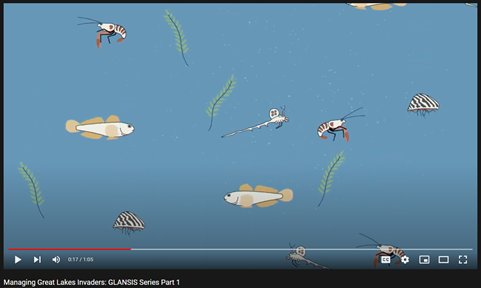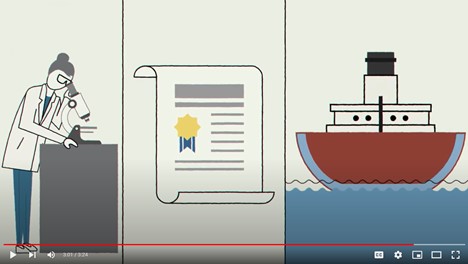Video series highlights invasive species, their management - and some success stories
The five-part short video series, Managing Great Lakes Invaders, was developed by Michigan Sea Grant and the Great Lakes Aquatic Nonindigenous Species Information System (GLANSIS)

Aquatic invasive species (AIS) are a major problem in the Great Lakes, where they disrupt food webs, destroy habitats, and harm businesses and recreation throughout the basin. Dealing with these aquatic invaders can be a daunting challenge, but scientists, elected officials, industry, and the public have successfully worked together to slow or stop their continuing spread. A new animated video series developed by the Great Lakes Aquatic Nonindigenous Species Information System (GLANSIS) and Michigan Sea Grant tells the story of how some of the Great Lakes’ worst invaders were introduced to the region – and highlights management victories and the future of AIS research along the way.

The five-part video series, Managing Great Lakes Invaders, was developed in collaboration with AIS experts and regional partners and produced by Big Foot Media. Each short video focuses on a different Great Lakes invasion story, including ballast water, sea lamprey, dreissenid mussels, and invasive carp, along with a capstone video that unites them.
- The “Ballast Water” video shows how organisms stowing away in the ballast tanks of ocean-going vessels have had a dramatic impact on Great Lakes invasion rates, until a combination of new technology and legislation cut off this invasion vector.
- “Sea Lamprey” showcases the effects of an invasive, parasitic fish that devastated Great Lakes fisheries until technological breakthroughs – and vigilant management – turned the tide.
- “Zebra and Quagga Mussels” demonstrates how tiny dreissenid mussels have enormous ecological and economic impacts on the Great Lakes and beyond, and how businesses and residents are adapting to live with them as research into new control methods continues.
- Finally, “Invasive Carp” addresses the looming threat posed by four introduced species of fish – bighead, silver, black, and grass carp – and the basin-wide effort to keep them out of the Great Lakes.

A playlist of the Managing Great Lakes Invaders video series is available online at Michigan Sea Grant’s YouTube account. The goal of these videos is to highlight AIS success stories and the ongoing research and collaboration that is essential to the fight against aquatic invaders. This project demonstrates how cooperation between researchers, legislators, industry, and other stakeholders can make a powerful difference in protecting the Great Lakes.
To learn more about the species featured in this video series, check out the GLANSIS database or contact program manager Rochelle Sturtevant at rochelle.sturtevant@noaa.gov.
Michigan Sea Grant helps to foster economic growth and protect Michigan’s coastal, Great Lakes resources through education, research and outreach. A collaborative effort of the University of Michigan and Michigan State University and its MSU Extension, Michigan Sea Grant is part of the NOAA-National Sea Grant network of 34 university-based programs.
This article was prepared by Michigan Sea Grant Extension under award NA180AR4170102 from the National Oceanic and Atmospheric Administration, U.S. Department of Commerce through the Regents of the University of Michigan. The statements, findings, conclusions, and recommendations are those of the author(s) and do not necessarily reflect the views of the National Oceanic and Atmospheric Administration, the Department of Commerce, or the Regents of the University of Michigan. This project was also supported by the Great Lakes Restoration Initiative.



 Print
Print Email
Email

